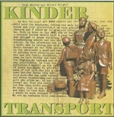| |
|
By Susan Bulanda The Holocaust, one of the most horrible events in recent
history, has yet one untold chapter–the pets owned by the Holocaust victims.
Today we understand the depth of the human/animal bond, but no one has told the
stories about what the pets of Holocaust victims meant to them.
When researching this topic, survivors said that they were glad someone cared
enough to ask about their pets. The fact that they needed to share their stories
is testimony to how much their pets meant to them.
The account below is a dramatization of actual events as told to the author.
Hungary
By K. R.
It was around 1939 when my father brought a small, furry puppy home. His eyes
were like liquid chocolate and he would give us little kisses. All five of us,
my parents, older brother, sister and me, loved to hold him and bury our face in
his soft, shiny fur. Bogar, a 20 pound, all black mixed breed dog made us laugh
and followed us everywhere. He was a constant source of joy, amusement and
companionship to us. I felt very close to Bogar and told him all of my secrets.
Our family managed to survive the first five years of the war. But the war had
affects on us all; even Bogar hated the sound of planes and shooting. Before we
could hear it, Bogar would growl and raise the hair on his back when an airplane
approached.
In June of 1944 we were marched to the Ghetto. We left Bogar free at home,
hoping that he would survive, but he followed us to the Ghetto. Since dogs were
not allowed in the Ghetto, we had no idea where he was or what happened to him.
Even though we were afraid and uncertain about our own fate, we all worried
about Bogar. Who would take care of him? How would he survive?
After three weeks we were herded out of the Ghetto and forced to walk to the
train station in Hajduhadhaz. To our surprise, when we left the Ghetto, Bogar
was right there beside us. He had waited outside of the Ghetto for us. I was
thrilled to see that he was alive, but he followed us all the way to the train
station where we had to leave him again. What would happen to our precious Bogar?
For an entire year, through all of our trials and tribulations, we wondered and
prayed for Bogar. Then on one glorious June day in 1945, we were free!!! We went
back to our home and looked for Bogar, but he was no where to be found. Though
we were glad to be alive, we mourned the loss of one family member, Bogar.
A month later, I was walking down the road about a mile from home when I saw a
dog that looked like Bogar. My heart skipped a beat and I held my breath as I
called his name. The dog stopped and looked, frozen in place. Then like a
shooting star, he ran to me, jumping and licking my hands and face. It was Bogar,
my sweet, wonderful Bogar!
The two of us ran home and I burst through the door shouting to the family, "Bogar's
home! Bogar's Home!" We hugged and kissed him, then gave him some of our
precious little food, water and a soft, warm place to sleep. After we got over
our excitement we saw that Bogar had had a rough life while we were gone. He was
thin, his coat did not shine and it seemed that there was a haunting look in his
eyes.
We found out from people in our neighborhood that he had lived on the street,
stealing food when he could. Bogar lived for a year or so and then at a little
over seven years of age, got sick and died. We all mourned, but for one glorious
year our family was complete and that meant a lot to us.
Note: If any reader knows about a Holocaust pet, please contact the author at
susanb21@juno.com or write to her at 15 Hemlock Dr., Jim Thorpe, PA 18229. |
|
|




 Bottom
Bottom













 Printer
friendly page
Printer
friendly page